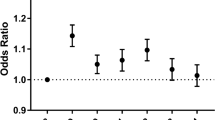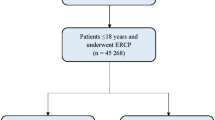Abstract
Background
Our aim was to assess the differences in outcomes of cholecystitis, pancreatitis, gastrointestinal (GI) bleed, GI perforation, and mortality in teaching versus nonteaching hospitals nationwide among therapeutic and diagnostic ERCPs. We hypothesized that complication rates would be higher in teaching hospitals given greater patient complexity.
Methods
Inpatient diagnostic and therapeutic ERCPs were identified from the National Inpatient Sample (NIS) from 2008 to 2012. The presence of ACGME-approved residency programs is required to qualify as a teaching hospital. Nonteaching urban and rural hospitals were grouped together. We identified hospital stays complicated by pancreatitis, cholecystitis, GI hemorrhage, perforation, and mortality. Logistic regression propensity-matched analysis was performed in SPSS to compare differences in complication rates between teaching and nonteaching hospitals.
Results
A total of 1,466,356 weighted cases of inpatient ERCPs were included in this study: of those, 367 and188 were diagnostic, 1,099,168 were therapeutic, 766,230 were at teaching hospitals, and 700,126 were at nonteaching hospitals. Mortality rates were higher in teaching hospitals when compared to nonteaching hospitals for diagnostic (OR 1.266, p < 0.001) and therapeutic ERCPs (OR 1.157, p = 0.001). There was no significant difference in rates of post-ERCP cholecystitis, pancreatitis, or perforation between the two groups. Among diagnostic ERCPs, GI hemorrhage was higher in teaching compared to nonteaching hospitals (OR 1.181, p = 0.003). Likewise, length of stay was increased in teaching hospitals (7.9 vs 6.9 days, p < 0.001, for diagnostic and 6.5 vs 5.8 days, p < 0.001, for therapeutic ERCPs).
Conclusions
In conclusion, teaching hospitals were noted to have a higher mortality rate associated with inpatient ERCPs as well as higher rates of GI hemorrhage in diagnostic ERCPs, which may be due to a higher comorbidity index in those patients admitted to teaching hospitals.
Similar content being viewed by others
References
Hyder O, Sachs T, Ejaz A, Spolverato G, Pawlik TM (2013) Impact of hospital teaching status on length of stay and mortality among patients undergoing complex hepatopancreaticobiliary surgery in the USA. J Gastrointest Surg 17(12):2114–2122
Pant S, Patel S, Golwala H, Patel N, Pandey A, Badheka A et al (2016) Transcatheter aortic valve replacement complication rates in teaching vs non-teaching centers in the United States. J Invasive Cardiol 28(2):67–70
Ananthakrishnan AN, McGinley EL, Saeian K (2008) Effect of hospital volume and teaching status on outcomes of acute liver failure. Liver Transpl 14(9):1347–1356
Dimick JB, Cowan JA Jr, Colletti LM, Upchurch GR Jr (2004) Hospital teaching status and outcomes of complex surgical procedures in the United States. Arch Surg 139(2):137–141
International Working Party to Promote Revitalise Academic Medicine (2004) Academic medicine: the evidence base. BMJ 329(7469):789
Au AG, Padwal RS, Majumdar SR, McAlister FA (2014) Patient outcomes in teaching versus nonteaching general internal medicine services: a systematic review and meta-analysis. Acad Med 89(3):517–523
Shelton J, Kummerow K, Phillips S, Arbogast PG, Griffin M, Holzman MD et al (2014) Patient safety in the era of the 80-hour workweek. J Surg Educ 71(4):551–559
Papanikolaou PN, Christidi GD, Ioannidis JP (2006) Patient outcomes with teaching versus nonteaching healthcare: a systematic review. PLoS Med 3(9):e341
Adler DG, Baron TH, Davila RE, Egan J, Hirota WK, Leighton JA et al (2005) ASGE guideline: the role of ERCP in diseases of the biliary tract and the pancreas. Gastrointest Endosc 62(1):1–8
Huang RJ, Thosani NC, Barakat MT, Choudhary A, Mithal A, Singh G et al (2017) Evolution in the utilization of biliary interventions in the United States: results of a nationwide longitudinal study from 1998 to 2013. Gastrointest Endosc 86(2):319–326
Jamal MM, Yoon EJ, Saadi A, Sy TY, Hashemzadeh M (2007) Trends in the utilization of endoscopic retrograde cholangiopancreatography (ERCP) in the United States. Am J Gastroenterol 102(5):966
Vandervoort J, Soetikno RM, Tham TC, Wong RC, Ferrari AP Jr, Montes H et al (2002) Risk factors for complications after performance of ERCP. Gastrointest Endosc 56(5):652–656
Christensen M, Matzen P, Schulze S, Rosenberg J (2004) Complications of ERCP: a prospective study. Gastrointest Endosc 60(5):721–731
Anderson MA, Fisher L, Jain R, Evans JA, Appalaneni V, Ben-Menachem T et al (2012) Complications of ERCP. Gastrointest Endosc 75(3):467–473
Szary NM, Al-Kawas FH (2013) Complications of endoscopic retrograde cholangiopancreatography: how to avoid and manage them. Gastroenterol Hepatol 9(8):496
Koc B, Bircan HY, Adas G, Kemik O, Akcakaya A, Yavuz A et al (2014) Complications following endoscopic retrograde cholangiopancreatography: minimal invasive surgical recommendations. PLoS ONE 9(11):e113073
Wu HM, Dixon E, May GR, Sutherland FR (2006) Management of perforation after endoscopic retrograde cholangiopancreatography (ERCP): a population-based review. HPB 8(5):393–399
Agency for Healthcare Research Quality. HCUP Databases. Healthcare Cost and Utilization Project (HCUP). 2012.
Agency for Healthcare Policy Research. Comparative analysis of HCUP and NHDS inpatient discharge data.
Inamdar S, Sejpal DV, Ullah M, Trindade AJ (2016) Weekend vs. weekday admissions for cholangitis requiring an ERCP: comparison of outcomes in a national cohort. Am J Gastroenterol 111(3):405–410
Njei B, McCarty TR, Laine L (2017) Early transjugular intrahepatic portosystemic shunt in US patients hospitalized with acute esophageal variceal bleeding. J Gastroenterol Hepatol 32(4):852–858
Garg SK, Anugwom C, Campbell J, Wadhwa V, Gupta N, Lopez R et al (2017) Early esophagogastroduodenoscopy is associated with better outcomes in upper gastrointestinal bleeding: a nationwide study. Endosc Int Open 5(5):E376
Inamdar S, Berzin TM, Sejpal DV, Pleskow DK, Chuttani R, Sawhney MS et al (2016) Pregnancy is a risk factor for pancreatitis after endoscopic retrograde cholangiopancreatography in a national cohort study. Clin Gastroenterol Hepatol 14(1):107–114
Andriulli A, Loperfido S, Napolitano G, Niro G, Valvano MR, Spirito F et al (2007) Incidence rates of post-ERCP complications: a systematic survey of prospective studies. Am J Gastroenterol 102(8):1781
Elixhauser A, Steiner C, Harris DR, Coffey RM (1998) Comorbidity measures for use with administrative data. Med Care 36(1):8–27
Menendez ME, Neuhaus V, van Dijk CN, Ring D (2014) The Elixhauser comorbidity method outperforms the charlson index in predicting inpatient death after orthopaedic surgery. Clin Orthop Relat Res 472(9):2878–2886
John J, Seifi A (2016) Incidence of iatrogenic pneumothorax in the United States in teaching vs. non-teaching hospitals from 2000 to 2012. J Crit Care 34:66–68
Simmer TL, Nerenz DR, Rutt WM, Newcomb CS, Benfer DW (1991) A randomized, controlled trial of an attending staff service in general internal medicine. Med Care 1991:JS31–JS40
Dynan L, Stein R, David G, Kenny LC, Eckman M, Short AD (2009) Determinants of hospitalist efficiency: a qualitative and quantitative study. Med Care Res Rev 66(6):682–702
O'Connor AB, Lang VJ, Bordley DR (2011) Restructuring an inpatient resident service to improve outcomes for residents, students, and patients. Acad Med 86(12):1500–1507
O'Connor AB, Lang VJ, Lurie SJ, Lambert DR, Rudmann A, Robbins B et al (2009) The effect of nonteaching services on the distribution of inpatient cases for internal medicine residents. Acad Med 84(2):220–225
Acknowledgements
We thank Richard Hajjar, MD for his insight and assistance with the statistical analysis.
Author information
Authors and Affiliations
Contributions
Conception and design: all authors. Acquisition, analysis, and interpretation of data: all authors. Drafting of the manuscript: all authors. Critical revision of the manuscript for important intellectual content: all authors. Statistical analysis: LR and FA. Administrative, technical, or material support: all authors. Study supervision: SA. All authors approved the final version of the manuscript.
Corresponding author
Ethics declarations
Disclosures
Authors Laura Rotundo, Faiz Afridi, Mirela Feurdean and Sushil Ahlawat have no conflict of Interest or financial ties to disclose.
Additional information
Publisher's Note
Springer Nature remains neutral with regard to jurisdictional claims in published maps and institutional affiliations.
Electronic supplementary material
Below is the link to the electronic supplementary material.
Rights and permissions
About this article
Cite this article
Rotundo, L., Afridi, F., Feurdean, M. et al. Effect of hospital teaching status on endoscopic retrograde cholangiopancreatography mortality and complications in the USA. Surg Endosc 35, 326–332 (2021). https://doi.org/10.1007/s00464-020-07403-z
Received:
Accepted:
Published:
Issue Date:
DOI: https://doi.org/10.1007/s00464-020-07403-z




